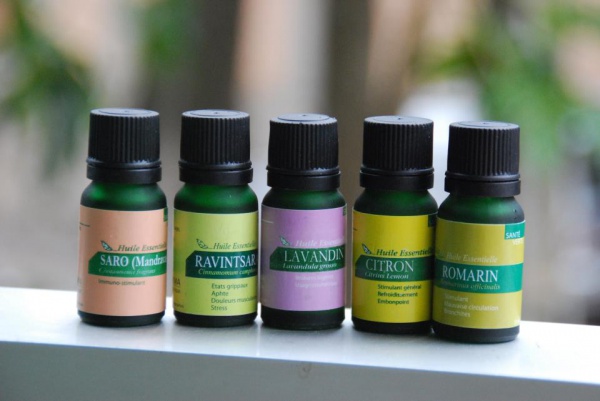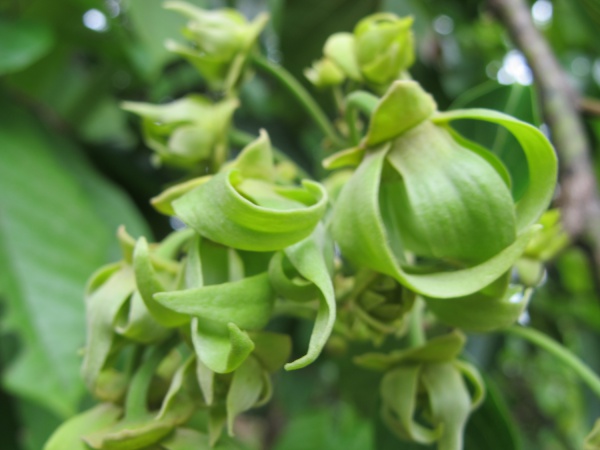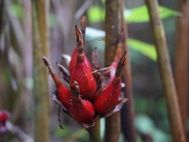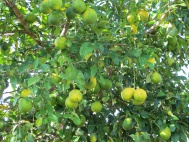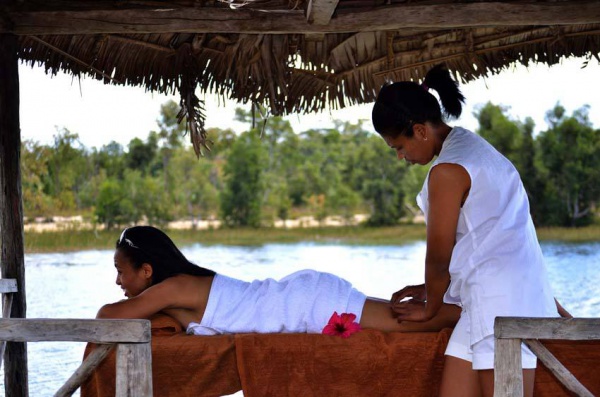Difference between revisions of "On the Trail of Essential Oils with Homeopharma"
CampMaster (talk | contribs) (→The concept of Homeopharma) |
|||
| (151 intermediate revisions by 3 users not shown) | |||
| Line 1: | Line 1: | ||
| − | + | '''Come and discover with Homeopharma Madagascar's biodiversity, the country's wealth of endemic flora with its aromatic and medicinal plants of an estimated 12,000 species. This is surely one of the richest and most diverse flora in the world.''' | |
| − | + | {| class="imageTable" | |
| + | |- | ||
| + | |colspan="3" | [[File:Ivato Farm 002.jpg|600px]] | ||
| + | |- | ||
| + | |[[File:Paradise found 017.jpg|196px]] | ||
| + | |align="center"|[[File:La_Residence_du_Cap_025.jpg|196px]] | ||
| + | |align="right"|[[File:Isalo_National_Park_003.jpg|196px]] | ||
| + | |- | ||
| + | |} | ||
| − | Indeed, Madagascar offers a wide diversity of all life forms: micro-organisms, plants and animals. 12,000 plant species, 3% of those | + | Indeed, Madagascar offers a wide diversity of all life forms: micro-organisms, plants and animals. 12,000 plant species, 3% of those on the entire planet, thrive on the island of Madagascar, also known as the forgotten continent! Many are endemic. They exist only in Madagascar. Over centuries, Malagasy people have studied this plant richness and gained knowledge of the active agents of countless medicinal plants and how to extract their hidden wealth, sometimes with miraculous powers: the essential oils. |
| − | Many are endemic. They exist only in Madagascar. | ||
| − | == | + | == The concept of Homeopharma == |
| − | + | [[Homeopharma]] is a pharmaceutical establishment approved by the [http://www.sante.gov.mg Ministry of Health] that is specialised in herbal medicine, aromatherapy, renewal of traditional medicine and homeopathy. Located in [[Antananarivo]], its founder [[Jean Claude Ratsimivony]] is a symbolic figure of the Big Island known for his long-standing commitment to innovation in the field of wellness and health. The new CEO since 2017, [[Feride Ismael]], manages the organisation according to its founding principles. | |
| + | Homeopharma employs 490 workers and uses over 1,500 plants in the production of its natural products. | ||
| − | + | [[File:Homeopharma logo.jpg|300px|thumb|left|Homeopharma logo]] | |
| − | + | Homeopharma manages the complete production process from planting to finished products. Over many parts of the island, Homeopharma plants, picks and harvests in total 600 hectares of forest, supervises and motivates farmers in the protection and renewal of plant resources, thus helping preserve the environment and biodiversity of Madagascar. | |
| − | + | In Madagascar, Homeopharma's presence include a total of 40 institutes where the final products are offered at modest prices, so as to allow all Malagasy people to benefit from the preventive and curative properties of their products. These institutes also offer care and free advice. They practise relaxing or slimming massages with essential oils, amongst them the best in the world such as [[ravintsara]] or [[katrafay]], all resulting from aromatic plants. | |
| − | + | A massage of not longer than 20 minutes is the time needed for a quality essential oil to be traced back to the taste buds of the tongue when applied to the soles of the feet. Thanks to its extraordinary power of penetration, it quickly breaks through the skin to reach the bloodstream and with it back to the tongue, as it could reach any other organ that we would aim for, before being totally dissolved in the body. A true miracle! | |
| + | == Properties of essential oils == | ||
| + | |||
| + | In its distillery centres Homeopharma extracts the essential substances of many plants: their aromas. Once collected in flasks, the natural concentrate may heal those who suffer from ailments, such as stress, warts, insomnia, the affection of sinus, ears or larynx, rheumatism, flu symptoms, impotence, stomach pain. | ||
| + | |||
| + | |||
| + | '''Definition of an essential oil''' | ||
| + | |||
| + | But what exactly is an essential oil? It can be defined as a powerful aromatic substance of complex composition, which includes volatile and odorous elements contained in plants. These are the elements that can help cure many diseases. | ||
| + | |||
| + | [[File:Homeopharma 0057.jpg|600px]] | ||
| + | |||
| + | '''How do you get this aromatic substance?''' | ||
| + | |||
| + | In most cases by steam distillation at low temperature and low pressure. This technique allows to extract most of the active substances from the plant. Before distillation they are called essence. After it is called essential oil. Only 10% of plants produce an essence. And when this is the case, although the essence can be found throughout the plant, it is mainly concentrated in a single organ, such as root, rhizome, wood, bark, leaf, stem, flower, seed or fruit. These are the organs from which essential oil is obtained. | ||
| + | |||
| + | {| class="imageTable" | ||
| + | |- | ||
| + | |colspan="3"|<div style="margin-bottom:-1.5ex;">[[File:Sambirano 007.jpg|thumb|none|600px|Ylang-ylang]]</div> | ||
| + | |- | ||
| + | |[[File:Lantana flower 001.jpg|thumb|none|189px|Lantana]] | ||
| + | |align="center"|[[File:Tampolodge 344.jpg|thumb|none|189px|Ginger root]] | ||
| + | |align="right"|[[File:20120506 142019 img 8265.jpg|189px|thumb|none|Orange tree]] | ||
| + | |- | ||
| + | |} | ||
| + | |||
| + | Distilled are ylang-ylang flowers, cinnamon bark, niaouli leaves or vetiver roots. Please note, the composition of the essence of a plant differs slightly from that of the essential oil of the same plant, because the distillation process cannot entirely extract the properties within the plant. | ||
| + | |||
| + | The essential oil of mint is easier to extract because of the leaves. A slightly irregular low heat is enough. But a bit stronger heat is needed to break down the structure of a bark and to release its larger aromatic molecules. <!-- Still, the plant will release only a part of its ... properties. --> | ||
| + | |||
| + | Citrus essential oil (orange, bergamot, lemon, mandarin) is obtained by squeezing the exocarp, the outer skin of the fruits, at room temperature. | ||
| + | |||
| + | |||
| + | '''Properties of Madagascar's essential oils''' | ||
| + | |||
| + | Throughout the entire production of essential oils, Madagascar ranks at the top. Firstly, due to the rarity of certain plants. Katrafay, extraordinary analgesic (pain-relieving), grows only on the Big Island. | ||
| + | |||
| + | The quality of plants is important too. A ravintsara from India holds less active ingredients than a ravintsara from Madagascar. | ||
| + | |||
| + | Another advantage is the environment. "The exceptionally rich and diverse terroirs of this island do not face pollution as in industrialised countries", remarked a french manufacturer, who use Malagasy essential oils in his products in Europe. And producers do not use chemical fertilisers either. These factors ensure the properties of plants to be 100% natural. | ||
| + | |||
| + | The cultivation of plants in Madagascar cannot be compared with many other countries. Whilst elsewhere trees of a single species are aligned in a field, in Madagascar a wild environment is kept where ravintsara grows next to ''[[Eucalyptus globulus]]'' but also next to plants and non-aromatic trees. | ||
| + | |||
| + | |||
| + | '''The essential oils of Homeopharma''' | ||
| + | |||
| + | This wild environment ensures the quality of the soil. | ||
| + | The essential oils of Homeopharma are tested and guaranteed in their laboratory to be of the highest quality. | ||
| + | |||
| + | |||
| + | Without the wild environment, the synergy between species would be lost. Plants need to breathe and sense. We must listen to Jean Claude, depository of remedies collected by his grandfather from traditional healers, who will tell you about the plants, their sensitivity, their stress before a cyclone. Resting time, which allows the plants to regenerate between pickings, is also respected and can reach up to four years depending on the species! Harvesting of plant organs is done in jute or cotton bags to prevent maceration. Partial drying is necessary in case of rain in order to reduce the amount of water contained in the plant. And if so, only one type of plant will be dried at the time to avoid contamination and ensure the right balance of chemical properties. | ||
| + | |||
| + | In short, the plants are treated for the treasures they are. And it doesn't stop there! Distillation over a wood fire, most of the time, is another added value to the Malagasy essential oils. In other countries it is done with regular gas heat. But firewood allows a variation of temperature which leads to a more complete extraction. The large molecules of the plants do not extract at a constant temperature if using gas. To be convinced of the importance of this, one needs only to observe the technicians at the Homeopharma distillery in [[Amparihy, Vontovorona]]. Their work procedure involves adding a piece of wood to light the fire and thereafter removing it to reach the desired temperature, causing a gradual temperature change. | ||
| + | |||
| + | And there is minimum waste, although essential oils are a luxury item which normally require a lot of raw material. For example, 390 kilos of niaouli flowers give only 2.2 liters of oil! | ||
| + | |||
| + | ''The regions of the Big Island and their essential oils are:'' | ||
| + | |||
| + | * ''The central highlands'' - a mosaic of mountains, basins, plains and hills, provide thyme, eucalyptus, cypress, helichrysum, geranium, lemongrass, basil, citriodora and ravintsara. | ||
| + | |||
| + | * ''The east of the country'' - an area regularly flooded due to trade winds bringing rainfall, provides [[Madagascar Cloves|cloves]], [[Madagascar Pepper|pepper]], [[Madagascar Cinnamon|cinnamon]], lantana, niaouli, vetiver, ginger, lemongrass and pink pepper. | ||
| + | |||
| + | * ''The drier west to the south'' - provides combava, lemon, cinnamon, mandravasarotra and sandalwood. | ||
| + | |||
| + | * ''The north, on the side of Antsiranana and the Amber Mountain'' - an area full of fragrant plants such as ylang-ylang, patchouli, geranium, basil and green pepper. | ||
| + | |||
| + | This abundance becomes even more valuable given the choice between unitary oils and complex oils, or mixtures of unitary oils. These mixtures of unitary oils further strengthens the properties of each of them. | ||
| + | |||
| + | ''Warning: never mix more than four oils because beyond that they neutralise each other. '' | ||
| + | |||
| + | == Improved traditional remedies (Remèdes traditionnelles améliorées - RTA) and massages == | ||
| + | |||
| + | Madagascar is a treasure trove for essential oils and this is also true outside of the actual production. Everything done here contributes towards the development of improved traditional remedies, also referred to as "RTA". | ||
| + | |||
| + | Firstly, because the cultivation of plants needed for essential oils is part of the reforestation of the Malagasy forest. Apart from the reforestation, have a look at the fragrant plants. The Malagasy reservoir of fragrant plants is so vast that we do not yet know all the species, nor therefore all the benefits we can derive from them. This is an area open for research, national and international, to further explore and protect. | ||
| + | |||
| + | Furthermore, these oils support another part of the Malagasy culture: massages. At a time when it has become fashionable to have all kinds of exotic body therapies, the Malagasy offer the classic massage, a palpating and rolling massage, energetic and gentle, whose effects are increased by massage oils consisting of up to 10% essential oils. | ||
| + | |||
| + | [[File:Homeopharma 0067.jpg|600px]] | ||
| + | |||
| + | It goes without saying that this palpate and roll massage will be more beneficial than simply an exchange between the person being massaged and the masseur who will be rich. Giving a massage is art. Also receiving. This is often forgotten. What do the hands which treat you with essential oils have to give? The art of Malagasy living! This way of life with calm and serenity is called [[mora mora]]. And without forgetting the smile of the people here, this is a primary source of wellness in Madagascar. | ||
| + | |||
| + | |||
| + | == Homeopharma Institutes throughout Madagascar == | ||
| + | |||
| + | There are about 40 Homeopharma institutes located throughout Madagascar. For those travelling around the country, ask for a Homeopharma institute near your hotel. There is even a Homeopharma shop at [[Ivato International Airport]] giving travellers a first and last opportunity to stock up Homeopharma's products. Most of the institutes around the country offer massages with essential oils and at reasonable prices, allowing you to relax while enjoying nature's benefits. | ||
| + | |||
| + | [[File:Homeopharma 0064.jpg|600px]] | ||
| + | |||
| + | |||
| + | __NOTOC__ | ||
| + | |||
| + | <!-- | ||
== Sur la route des Huiles essentielles avec HOMEOPHARMA
== | == Sur la route des Huiles essentielles avec HOMEOPHARMA
== | ||
| Line 40: | Line 140: | ||
* Un massage de vingt petites minutes est le temps nécessaire à une huile essentielle de qualité, appliquée sur la plante des pieds, pour remonter jusqu’aux papilles du goût, sur la langue. Grâce à son pouvoir de pénétration extraordinaire, elle franchit vite la peau, pour atteindre le sang et, par lui, remonter jusqu’à la langue, comme elle pourrait atteindre un autre organe que l’on souhaiterait viser, avant de s’éliminer totalement dans l’organisme. Un vrai miracle ! | * Un massage de vingt petites minutes est le temps nécessaire à une huile essentielle de qualité, appliquée sur la plante des pieds, pour remonter jusqu’aux papilles du goût, sur la langue. Grâce à son pouvoir de pénétration extraordinaire, elle franchit vite la peau, pour atteindre le sang et, par lui, remonter jusqu’à la langue, comme elle pourrait atteindre un autre organe que l’on souhaiterait viser, avant de s’éliminer totalement dans l’organisme. Un vrai miracle ! | ||
| + | |||
| + | |||
| + | == 2. Propriétés des huiles essentielles : == | ||
| + | |||
| + | A travers ses centres de distillerie, HOMEOPHARMA tire la substantifique moelle de nombreuses plantes : leurs arômes. Une fois recueillis dans des flacons, ces concentrés de nature pourront guérir ceux qui les utiliseront de bien des maux : stress, verrues, insomnies, affections des sinus, des oreilles et du larynx, rhumatismes, états grippaux, impuissance, douleurs d'estomac, et tant d'autres. | ||
| + | |||
| + | |||
| + | '''Définition d'une huile essentielle :''' | ||
| + | |||
| + | Mais qu'est-ce, exactement, qu'une huile essentielle ? On peut la définir comme une puissante substance aromatique, de composition complexe, qui renferme des éléments volatils et odorants, contenus dans les végétaux. Ce sont ces éléments qui aident à la guérison de nombreuses maladies. | ||
| + | |||
| + | |||
| + | '''Comment obtient-on cette substance aromatique ?''' | ||
| + | |||
| + | Le plus souvent, par distillation à la vapeur d'eau à basse température et basse pression. Cette technique permet d'extraire de la plante la plupart des principes actifs. Avant distillation, ceux-ci se nomment essence. Après, on parle d'huile essentielle. Seuls 10% des végétaux produisent une essence. Et si celle-ci, quand elle est présente, se trouve dans toute la plante, elle se concentre surtout dans ''un seul organe : racine, rhizome, bois, écorce, feuille, tige, fleur, sommité fleurie, graine ou fruit. C'est cet organe qu'on récolte pour obtenir l'huile essentielle.'' | ||
| + | |||
| + | On distille donc les fleurs d'ylang-ylang, l'écorce de cannelle, les feuilles de niaouli ou les racines de vétiver. Attention, la composition de l'essence d'une plante diffère légèrement de celle de l'huile essentielle de cette même plante, car la distillation ne parvient pas à tout extraire du végétal. | ||
| + | |||
| + | L'huile essentielle de menthe est facile à obtenir parce qu'on part des feuilles. Un feu doux légèrement irrégulier suffit. Mais des coups de chaleur un peu plus forts seront nécessaires pour parvenir à casser la structure d'une écorce et à en dégager ses plus grosses molécules aromatiques. Et encore, la plante ne libérera qu'une partie de celles-ci. » | ||
| + | |||
| + | L'huile essentielle des Citrus (orange, bergamote, citron, mandarine) s'obtient, elle, par expression à température ambiante de l'épicarpe, la peau extérieure des fruits. | ||
| + | |||
| + | |||
| + | '''Propriétés des Huiles essentielles de Madagascar :''' | ||
| + | |||
| + | Madagascar, tout au long de la production des huiles essentielles, accumule les atouts. D'abord, la rareté de certains végétaux. | ||
| + | |||
| + | Le katrafay, extraordinaire antalgique, ne pousse que sur la Grande Ile. | ||
| + | |||
| + | La qualité des végétaux importe aussi. Un ravintsara d'Inde a moins de principes actifs qu'un ravintsara d'ici. | ||
| + | |||
| + | Autre atout, l'environnement. « Les terroirs exceptionnellement riches et divers de cette île ne connaissent pas de pollution comme dans les pays industrialisés, fait remarquer le cardiologue Lionnel Michat, dont les huiles essentielles malgaches sont commercialisées en Europe sous la marque « Les Aromagies ». Et les producteurs n'utilisent pas non plus d'engrais chimiques. Tout cela renforce les propriétés des végétaux100% naturels. » | ||
| + | |||
| + | Le soin apporté à la culture des plantes compte aussi pour beaucoup. Quand, ailleurs, on aligne des arbres d'une seule espèce dans un champ, à Madagascar, on garde un environnement sauvage, où le ravintsara voisine avec l'eucalyptus globulus mais aussi avec des plantes et arbres non aromatiques. | ||
| + | |||
| + | |||
| + | '''Les Huiles essentielles de HOMEOPHARMA''' | ||
| + | |||
| + | Cet environnement sauvage est garant de la qualité du terroir, d'après Jean Claude RATSIMIVONY, le fondateur d'HOMEOPHARMA, laboratoire connu pour ses huiles essentielles de grande qualité. | ||
| + | |||
| + | Sinon, on perd la synergie entre les espèces. Or les plantes ont besoin de s'exhaler et de se ressentir. » Il faut écouter « Jean Claude » cet humble petit-fils de docteur en médecine, dépositaire des remèdes recueillis par son aïeul chez les guérisseurs, vous parler des plantes, de leur sensibilité, de leur stress avant un ouragan. Le temps de repos, qui permet à la plante de se régénérer entre les cueillettes, est aussi respecté. Il peut atteindre quatre ans suivant les | ||
| + | espèces ! La récolte des organes végétaux se fait, elle, dans des sacs en jute ou en coton pour éviter toute macération. Un séchage partiel est nécessaire en cas de pluie afin de faire baisser la quantité d'eau contenue dans la plante. Et là, on ne fera sécher qu'un seul type de plante à la fois, pour éviter toute contamination et garantir les propriétés chimiques. | ||
| + | |||
| + | Bref, les plantes sont traitées à la hauteur du trésor qu'elles constituent. Et ce n'est pas fini ! Leur distillation au feu de bois, la plupart du temps, constitue l'autre grande valeur ajoutée des huiles essentielles malgaches. Dans d'autres pays, on se contente de la chaleur très régulière du gaz. | ||
| + | |||
| + | Or le feu de bois permet une variation de la température et conduit, on l'a vu, à une extraction plus complète. Car certains éléments de la plante, les grosses molécules, ne s'extraient pas avec une température constante comme celle du gaz. Pour se convaincre de l'importance de cette opération, il suffit d'observer les techniciens de la distillerie d'HOMEOPHARMA, à Ambila, sur le canal des Pangalanes, situé sur le bord de la côte est de Madagascar. Les voilà qui s'affairent à rajouter des brandons au feu de distillation, puis à en retirer, pour provoquer cette courbe de la température tant désirée. | ||
| + | |||
| + | Il faut d'autant moins gâcher le produit que les huiles essentielles sont un produit de luxe : elles nécessitent beaucoup de matière première. 390 kilos de fleurs de niaouli donnent seulement 2,2 litres d'huile! | ||
| + | |||
| + | ''A chaque région de la Grande Ile, ses huiles essentielles:'' | ||
| + | |||
| + | * ''Les hauts plateaux du centre'', mosaïque de montagnes, de cuvettes, de plaines et de collines, fournissent celles de thym, d'eucalyptus, de cyprès, d'hélichryse, de géranium, de citronnelle, de basilic, de citriodora et de ravintsara. | ||
| + | |||
| + | * ''Dans l'Est du Pays'', que le déluge des alizés arrose régulièrement, poussent le girofle, le poivre, la cannelle, le lantana, le niaouli, le vétiver, le gingembre, la citronnelle, encore, et les baies roses. | ||
| + | |||
| + | * ''Sur les terres plus arides de l'Ouest, jusqu'au Sud'', on récolte le combavas, le citron, le cinnamomum fragrens, ou mandravasarotra, et le santal. | ||
| + | |||
| + | * ''Le Nord, quant à lui, du côté d'Antsiranana et de la Montagne d'Ambre, regorge de plantes odorantes,'' odorantes, comme l'ylang-ylang, le patchouli, le géranium, le basilic et le poivre vert. | ||
| + | |||
| + | Cette profusion est d'autant plus précieuse qu'on a le choix entre des huiles unitaires et des complexes, ou mélanges, d'huiles unitaires. Ces mélanges d'huiles unitaires potentialisent les propriétés de chacune d'entre elles. | ||
| + | |||
| + | ''Attention, jamais plus de quatre huiles car au-delà, elles se neutralisent.'' | ||
| + | |||
| + | == 3. Remèdes traditionnelles améliorées (RTA) et Massages : == | ||
| + | |||
| + | * Madagascar, écrin pour les huiles essentielles : c'est aussi vrai en dehors de la production proprement dite. Tout contribue, ici, au développement de ces | ||
| + | remèdes traditionnels améliorés ou dénommés aussi « RTA ». | ||
| + | |||
| + | * D'abord, parce que la culture des plantes nécessaires à ces huiles s'inscrit dans le cadre du reboisement de la forêt malgache. | ||
| + | |||
| + | * Quitte à reboiser, autant choisir des plantes odorantes. Et, autre avantage, le réservoir malgache de végétaux odoriférants est si vaste qu'on n'en connaît pas | ||
| + | encore toutes les espèces ni, donc, tous les bénéfices qu'on pourra en retirer. La voie est libre pour la recherche, nationale et internationale. | ||
| + | |||
| + | * Enfin, ces huiles épousent un autre pan de la culture de la Grande Ile : le massage. Pas de chichis dans ces massages. A l'heure où l'on voit se développer toutes sortes de thérapies corporelles qui rivalisent d'exotisme et de snobisme, les Malgaches proposent un massage classique, le palper-rouler, énergique et doux, dont les effets sont accrus par les huiles de massage composées à 10% d'huiles essentielles. | ||
| + | |||
| + | * Il va sans dire que ce palper-rouler sera d'autant plus bénéfique que l'échange entre la personne massée et le masseur sera riche. | ||
| + | |||
| + | * Transmettre un massage est tout un art. Le recevoir aussi. On l'oublie souvent. Qu'ont-elles à donner, ces mains qui vous oignent d'huiles essentielles ? L'art | ||
| + | de vivre malgache. | ||
| + | |||
| + | * Cette façon de considérer la vie avec calme et sérénité, appelée mora-mora. | ||
| + | |||
| + | C'est, sans oublier le sourire des gens d'ici, la première source de bien-être de Madagascar. | ||
| + | |||
| + | |||
| + | |||
| + | |||
| + | Guide pratique des massages effectués dans les quarante (40) Instituts HOMEOPHARMA répartis dans tout Madagascar | ||
| + | |||
| + | Une quarantaine d'Instituts sont répartis dans tout Madagascar et dans les trois Green Clubs de HOMEOPHARMA. | ||
| + | |||
| + | * Mais si vous vous trouvez dans une autre ville qu'Antananarivo, « en province », | ||
| + | |||
| + | * Dès votre arrivée à Madagascar renseignez-vous pour savoir s'il y aurait un Institut HOMEOPHARMA à côté de votre hôtel, car même à l'Aéroport d'Ivato un point de vente des produits HOMEOPHARMA y est ouvert pour permettre aux voyageurs de faire leurs premières ou leurs derniers approvisionnements de produits HOMEOPHARMA ? | ||
| + | |||
| + | * La plupart de ces Instituts proposent des massages aux huiles essentielles à des prix modiques vous permettant de se relaxer tout en profitant des bienfaits de la nature. | ||
| + | |||
| + | --> | ||
Latest revision as of 05:58, 20 August 2018
Come and discover with Homeopharma Madagascar's biodiversity, the country's wealth of endemic flora with its aromatic and medicinal plants of an estimated 12,000 species. This is surely one of the richest and most diverse flora in the world.
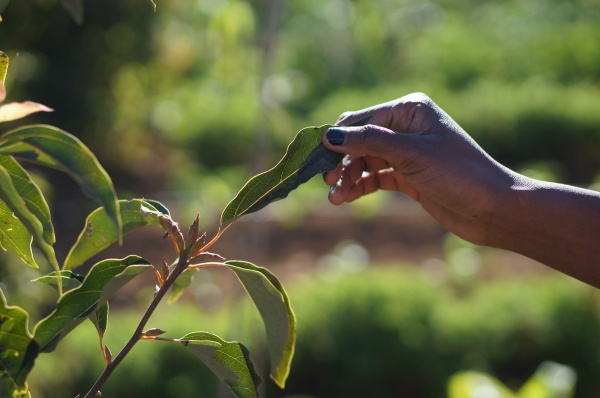
| ||
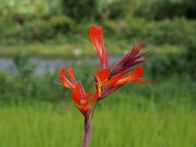
|

|
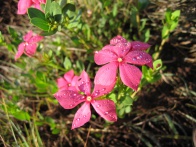
|
Indeed, Madagascar offers a wide diversity of all life forms: micro-organisms, plants and animals. 12,000 plant species, 3% of those on the entire planet, thrive on the island of Madagascar, also known as the forgotten continent! Many are endemic. They exist only in Madagascar. Over centuries, Malagasy people have studied this plant richness and gained knowledge of the active agents of countless medicinal plants and how to extract their hidden wealth, sometimes with miraculous powers: the essential oils.
The concept of Homeopharma
Homeopharma is a pharmaceutical establishment approved by the Ministry of Health that is specialised in herbal medicine, aromatherapy, renewal of traditional medicine and homeopathy. Located in Antananarivo, its founder Jean Claude Ratsimivony is a symbolic figure of the Big Island known for his long-standing commitment to innovation in the field of wellness and health. The new CEO since 2017, Feride Ismael, manages the organisation according to its founding principles. Homeopharma employs 490 workers and uses over 1,500 plants in the production of its natural products.
Homeopharma manages the complete production process from planting to finished products. Over many parts of the island, Homeopharma plants, picks and harvests in total 600 hectares of forest, supervises and motivates farmers in the protection and renewal of plant resources, thus helping preserve the environment and biodiversity of Madagascar.
In Madagascar, Homeopharma's presence include a total of 40 institutes where the final products are offered at modest prices, so as to allow all Malagasy people to benefit from the preventive and curative properties of their products. These institutes also offer care and free advice. They practise relaxing or slimming massages with essential oils, amongst them the best in the world such as ravintsara or katrafay, all resulting from aromatic plants.
A massage of not longer than 20 minutes is the time needed for a quality essential oil to be traced back to the taste buds of the tongue when applied to the soles of the feet. Thanks to its extraordinary power of penetration, it quickly breaks through the skin to reach the bloodstream and with it back to the tongue, as it could reach any other organ that we would aim for, before being totally dissolved in the body. A true miracle!
Properties of essential oils
In its distillery centres Homeopharma extracts the essential substances of many plants: their aromas. Once collected in flasks, the natural concentrate may heal those who suffer from ailments, such as stress, warts, insomnia, the affection of sinus, ears or larynx, rheumatism, flu symptoms, impotence, stomach pain.
Definition of an essential oil
But what exactly is an essential oil? It can be defined as a powerful aromatic substance of complex composition, which includes volatile and odorous elements contained in plants. These are the elements that can help cure many diseases.
How do you get this aromatic substance?
In most cases by steam distillation at low temperature and low pressure. This technique allows to extract most of the active substances from the plant. Before distillation they are called essence. After it is called essential oil. Only 10% of plants produce an essence. And when this is the case, although the essence can be found throughout the plant, it is mainly concentrated in a single organ, such as root, rhizome, wood, bark, leaf, stem, flower, seed or fruit. These are the organs from which essential oil is obtained.
Distilled are ylang-ylang flowers, cinnamon bark, niaouli leaves or vetiver roots. Please note, the composition of the essence of a plant differs slightly from that of the essential oil of the same plant, because the distillation process cannot entirely extract the properties within the plant.
The essential oil of mint is easier to extract because of the leaves. A slightly irregular low heat is enough. But a bit stronger heat is needed to break down the structure of a bark and to release its larger aromatic molecules.
Citrus essential oil (orange, bergamot, lemon, mandarin) is obtained by squeezing the exocarp, the outer skin of the fruits, at room temperature.
Properties of Madagascar's essential oils
Throughout the entire production of essential oils, Madagascar ranks at the top. Firstly, due to the rarity of certain plants. Katrafay, extraordinary analgesic (pain-relieving), grows only on the Big Island.
The quality of plants is important too. A ravintsara from India holds less active ingredients than a ravintsara from Madagascar.
Another advantage is the environment. "The exceptionally rich and diverse terroirs of this island do not face pollution as in industrialised countries", remarked a french manufacturer, who use Malagasy essential oils in his products in Europe. And producers do not use chemical fertilisers either. These factors ensure the properties of plants to be 100% natural.
The cultivation of plants in Madagascar cannot be compared with many other countries. Whilst elsewhere trees of a single species are aligned in a field, in Madagascar a wild environment is kept where ravintsara grows next to Eucalyptus globulus but also next to plants and non-aromatic trees.
The essential oils of Homeopharma
This wild environment ensures the quality of the soil. The essential oils of Homeopharma are tested and guaranteed in their laboratory to be of the highest quality.
Without the wild environment, the synergy between species would be lost. Plants need to breathe and sense. We must listen to Jean Claude, depository of remedies collected by his grandfather from traditional healers, who will tell you about the plants, their sensitivity, their stress before a cyclone. Resting time, which allows the plants to regenerate between pickings, is also respected and can reach up to four years depending on the species! Harvesting of plant organs is done in jute or cotton bags to prevent maceration. Partial drying is necessary in case of rain in order to reduce the amount of water contained in the plant. And if so, only one type of plant will be dried at the time to avoid contamination and ensure the right balance of chemical properties.
In short, the plants are treated for the treasures they are. And it doesn't stop there! Distillation over a wood fire, most of the time, is another added value to the Malagasy essential oils. In other countries it is done with regular gas heat. But firewood allows a variation of temperature which leads to a more complete extraction. The large molecules of the plants do not extract at a constant temperature if using gas. To be convinced of the importance of this, one needs only to observe the technicians at the Homeopharma distillery in Amparihy, Vontovorona. Their work procedure involves adding a piece of wood to light the fire and thereafter removing it to reach the desired temperature, causing a gradual temperature change.
And there is minimum waste, although essential oils are a luxury item which normally require a lot of raw material. For example, 390 kilos of niaouli flowers give only 2.2 liters of oil!
The regions of the Big Island and their essential oils are:
- The central highlands - a mosaic of mountains, basins, plains and hills, provide thyme, eucalyptus, cypress, helichrysum, geranium, lemongrass, basil, citriodora and ravintsara.
- The east of the country - an area regularly flooded due to trade winds bringing rainfall, provides cloves, pepper, cinnamon, lantana, niaouli, vetiver, ginger, lemongrass and pink pepper.
- The drier west to the south - provides combava, lemon, cinnamon, mandravasarotra and sandalwood.
- The north, on the side of Antsiranana and the Amber Mountain - an area full of fragrant plants such as ylang-ylang, patchouli, geranium, basil and green pepper.
This abundance becomes even more valuable given the choice between unitary oils and complex oils, or mixtures of unitary oils. These mixtures of unitary oils further strengthens the properties of each of them.
Warning: never mix more than four oils because beyond that they neutralise each other.
Improved traditional remedies (Remèdes traditionnelles améliorées - RTA) and massages
Madagascar is a treasure trove for essential oils and this is also true outside of the actual production. Everything done here contributes towards the development of improved traditional remedies, also referred to as "RTA".
Firstly, because the cultivation of plants needed for essential oils is part of the reforestation of the Malagasy forest. Apart from the reforestation, have a look at the fragrant plants. The Malagasy reservoir of fragrant plants is so vast that we do not yet know all the species, nor therefore all the benefits we can derive from them. This is an area open for research, national and international, to further explore and protect.
Furthermore, these oils support another part of the Malagasy culture: massages. At a time when it has become fashionable to have all kinds of exotic body therapies, the Malagasy offer the classic massage, a palpating and rolling massage, energetic and gentle, whose effects are increased by massage oils consisting of up to 10% essential oils.
It goes without saying that this palpate and roll massage will be more beneficial than simply an exchange between the person being massaged and the masseur who will be rich. Giving a massage is art. Also receiving. This is often forgotten. What do the hands which treat you with essential oils have to give? The art of Malagasy living! This way of life with calm and serenity is called mora mora. And without forgetting the smile of the people here, this is a primary source of wellness in Madagascar.
Homeopharma Institutes throughout Madagascar
There are about 40 Homeopharma institutes located throughout Madagascar. For those travelling around the country, ask for a Homeopharma institute near your hotel. There is even a Homeopharma shop at Ivato International Airport giving travellers a first and last opportunity to stock up Homeopharma's products. Most of the institutes around the country offer massages with essential oils and at reasonable prices, allowing you to relax while enjoying nature's benefits.

